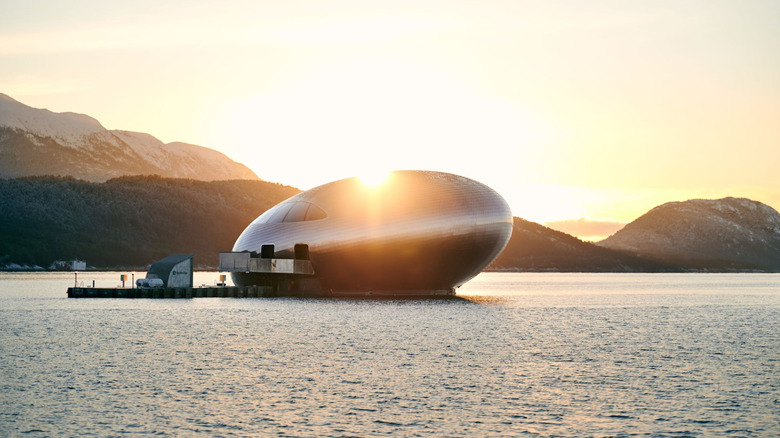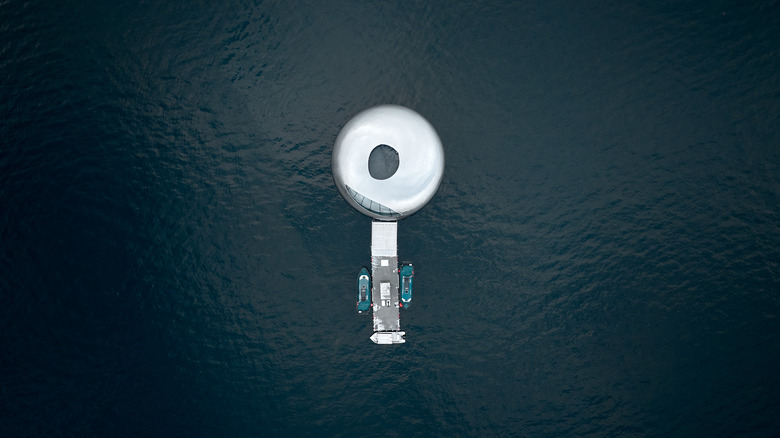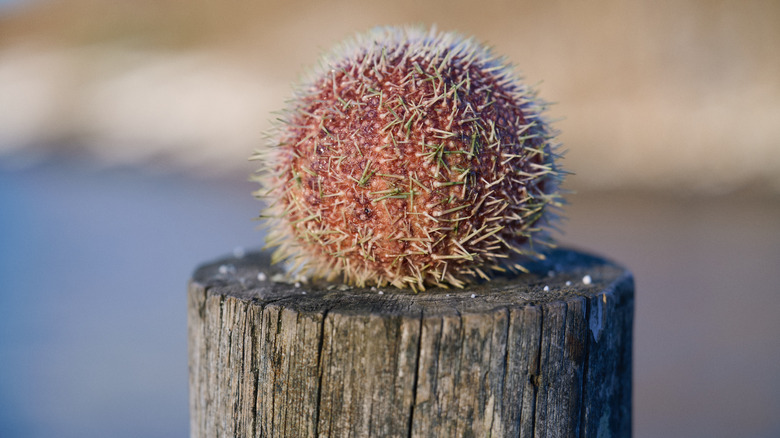The Restaurant Nestled In The Waves Of Norway's Fjords
You've heard of a destination wedding, but what about a destination dinner? That's what awaits patrons of Iris, a floating restaurant set in Hardangerfjord, the second-longest fjord in Norway. From the outside, it looks like an alien spacecraft just splashed down in the icy blue waters. The restaurant is housed within a silver structure called the Salmon Eye, which Visit Norway has referred to as "the world's largest floating art installation." From a bird's eye view, its discus shape and round rooftop terrace truly give the impression of an eyeball staring up at you. In addition to housing Iris, the Salmon Eye serves as a visitors' center dedicated to educating the public about Norway's aquaculture industry.
Iris caught the world's attention the moment it opened on June 21, 2023, with its remote, waterlocked location drawing comparisons to the fictional Hawthorn, the restaurant at the center of the 2022 film The Menu. Fortunately, Iris is not helmed by a madman, but rather by the acclaimed Danish chef Anika Madsen. After launching her culinary career at just 17 years of age, according to Elite Traveler, Madsen worked at some of Copenhagen's finest eateries, including a stint at Michelin-starred restaurant group Formel B.
Her goals for Iris transcend fine dining alone, positioning it as a landmark for sustainability where diners can come to better understand how their eating habits affect their local environment. Marrying food, art, and education, calling Iris a restaurant feels inadequate. It's entirely one-of-a-kind, so the only way to approach it is by casting all expectations aside and embracing Madsen's expansive vision.
Iris is more than a restaurant
The Iris website describes its service as "Expedition Dining." There couldn't be a more apt description than that; dining at Iris is a journey, beginning in the village of Rosendal on the shore of Hardangerfjord. From there, diners take a short boat ride to the island of Snilstveitøy, where they stop at Madsen's boathouse for a snack and a cup of cider, a specialty of the region.
After their island stopover, diners re-board the boat and head to the Salmon Eye. Inside the silver orb, there are four floors, the first of which is submerged beneath the surface of the fjord. After disembarking, guests descend to this subaquatic level and are guided through a "multisensory underwater experience," according to the restaurant's website. From there, according to Youtuber Alexander The Guest, the dining experience begins with a short film about food and its environmental impact, focusing on sustainability and the role of marine ecosystems. This is followed by a presentation on Iris's suppliers, all of whom are located in the Hardangerfjord area.
When dinner time arrives, the guests are led up a ramp to the dining room, where vast windows offer stunning views of the steep mountains that surround the fjord. The meal consists of 18 courses, which all follow the themes of environmentalism and sustainability. There are two meal services per night, and the restaurant only accepts 24 diners per day. All told this expedition dinner can take as long as six hours. The price is 3,200 Krone (approximately $285) per person, and parties of one are not permitted.
How Iris puts sustainability into action
Madsen's work in Copenhagen brought her face-to-face with the immense challenges facing the culinary world in light of climate change. She honed in on the value of locally sourced ingredients as tools for sustainability, building Iris's menu around the natural bounty of Hardangerfjord. In a press release, Madsen said, "It has always been close to my heart to lift the less known ingredients into the spotlight."
If there is one dish to exemplify the Iris approach to eating, it is their sea urchin. Business Norway explains that red sea urchins are an invasive species wreaking havoc in Norway's fjords. They devour entire kelp forests, turning the once-lively climate into a nautical desert wasteland. Considering the prized nature of sea urchin meat, eating them out of the area may be the best solution, and Iris is playing its part in the process. Madsen serves the sea urchin as part of a dish dubbed "unification," in which diners use kelp crackers to scoop up the creamy meat. There is a symbolic nature to the dish, pairing invader and native in a single bite. Other courses focus on sustainable proteins such as insects, algae, and fungi, and many of the dishes are plated so as to mimic scenes in nature.
Iris is still an infant in the restaurant scene, too new to have accrued any of the annual accolades bestowed by the culinary industry, but those are sure to come, just as Madsen's star in the Nordic food scene will surely continue to rise.


